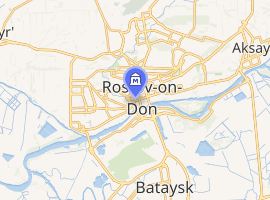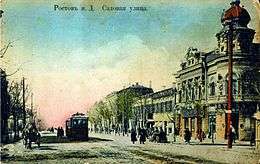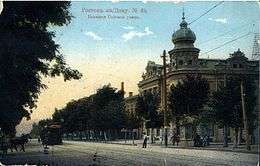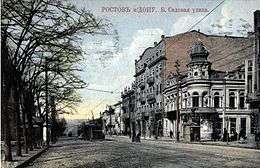Chernova House
Margarita Chernova House (Russian: Дом Маргариты Черновой) ― a mansion in the city of Rostov-on-Don, Russia. It was built in 1899 by architect N.A. Doroshenko.[1] It is considered to be an object of cultural heritage of regional importance.[2]
Дом Маргариты Черновой | |

| |
| Established | 1899 |
|---|---|
| Location | Rostov-on-Don |
| Type | Mansion |
History
At the end of 19th ― the beginning of the 20th century in the mansion were held receptions, musical performances, thrown balls and organized other remarkable city life events. The ground floor was rented by various trade organizations, in particular, by Shamkovich's Pharmacy and "Julius Garohov's Trade House." On the second floor, there were living rooms. Among other rooms, the hall contrasted with higher ceilings and luxurious interior decoration. The scene was located in the corner of the hall. From the hallway, it was possible to go to the balcony with a balustrade. Along the facade on Khalturinsky alley, there were situated a dining room, a living room, a bedroom, and other premises. Each of the rooms had been decorated with stucco, which was painted with oil.[1]
The main entrance to the building is situated at the corner of Bolshaya Sadovaya street and Khalturinsky alley. On both sides of the mansion there were placed false windows, decorated with stucco architraves. Above the corner portion rises a gazebo with a dome ― it is the composite core of the mansion. On the second floor there is a balcony with a balustrade. The facade is richly decorated with stucco: decorative vases in niches, Atlantes, caryatids, medallions, sea shells, garlands and floral ornament.[1][3]
In 1920 Chernova was evicted by Soviet authorities, and the building was nationalized. On the ground floor and in the basement located there was situated "Pharmacy № 2", and on the second floor ― "Children's commune № 5". According to 1926 data, the second floor was occupied by a Sewing school, while the first one was still a place for "Pharmacy № 2", for a newly established joint-stock company, and for "tenants of nine families living cramped: seven people in one room of the former trading room."[1]
On February 2, 1926, the mansion became Provincial Prosecutor's Office. Since 1940, the building housed the Communist party archive of the Rostov region, and after the collapse of the Soviet Union ― the State Archives of the Rostov region. By the early 2000s, the building was in disrepair. In 2001, the reconstruction of the building was carried out, during which the house was demolished and reconstructed again. In the process of restoring the building's original elements were used. Currently, the mansion houses a department of Bank of Moscow.[4]
Gallery
- Chernova house on postcards
 1909
1909 1910
1910 1916
1916
References
- Есаулов Г. В., Черницына В. А. (1999). Архитектурная летопись Ростова-на-Дону. Ростов-на-Дону. pp. 105–107. ISBN 5-8456-0433-8.
- "Ростов-на-Дону (объекты культурного наследия регионального значения)". Официальный портал Правительства Ростовской области. Archived from the original on 2013-09-14. Retrieved 2013-08-24.
- Кукушин B. C. (1995). "Эклектика". История архитектуры Нижнего Дона и Приазовья. Ростов-на-Дону: ГинГО. p. 275. ISBN 5-88616-027-2.
- "Дом Черновой - с.3". voopiik-don.ru. Archived from the original on 2013-09-15. Retrieved 2013-08-27.